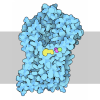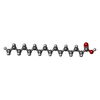+ データを開く
データを開く
- 基本情報
基本情報
| 登録情報 | データベース: PDB / ID: 7dpf | ||||||
|---|---|---|---|---|---|---|---|
| タイトル | Cryo-EM structure of Coxsackievirus B1 mature virion | ||||||
 要素 要素 |
| ||||||
 キーワード キーワード | VIRUS / Coxsackievirus B1 / mature virion / Cryo-EM | ||||||
| 機能・相同性 |  機能・相同性情報 機能・相同性情報symbiont-mediated suppression of host cytoplasmic pattern recognition receptor signaling pathway via inhibition of RIG-I activity / picornain 2A / symbiont-mediated suppression of host mRNA export from nucleus / symbiont genome entry into host cell via pore formation in plasma membrane / ribonucleoside triphosphate phosphatase activity / picornain 3C / T=pseudo3 icosahedral viral capsid / host cell cytoplasmic vesicle membrane / viral capsid / host cell ...symbiont-mediated suppression of host cytoplasmic pattern recognition receptor signaling pathway via inhibition of RIG-I activity / picornain 2A / symbiont-mediated suppression of host mRNA export from nucleus / symbiont genome entry into host cell via pore formation in plasma membrane / ribonucleoside triphosphate phosphatase activity / picornain 3C / T=pseudo3 icosahedral viral capsid / host cell cytoplasmic vesicle membrane / viral capsid / host cell / nucleoside-triphosphate phosphatase / channel activity / monoatomic ion transmembrane transport / DNA replication / RNA helicase activity / endocytosis involved in viral entry into host cell / symbiont-mediated suppression of host gene expression / symbiont-mediated activation of host autophagy / RNA-directed RNA polymerase / cysteine-type endopeptidase activity / viral RNA genome replication / RNA-directed RNA polymerase activity / DNA-templated transcription / symbiont entry into host cell / virion attachment to host cell / host cell nucleus / structural molecule activity / ATP hydrolysis activity / proteolysis / RNA binding / zinc ion binding / ATP binding / membrane 類似検索 - 分子機能 | ||||||
| 生物種 |  Coxsackievirus B1 (コクサッキーウイルス) Coxsackievirus B1 (コクサッキーウイルス) | ||||||
| 手法 | 電子顕微鏡法 / 単粒子再構成法 / クライオ電子顕微鏡法 / 解像度: 3.2 Å | ||||||
 データ登録者 データ登録者 | Zheng, Q. / Li, S. | ||||||
 引用 引用 |  ジャーナル: Cell Host Microbe / 年: 2021 ジャーナル: Cell Host Microbe / 年: 2021タイトル: Cryo-EM structures reveal the molecular basis of receptor-initiated coxsackievirus uncoating. 著者: Longfa Xu / Qingbing Zheng / Rui Zhu / Zhichao Yin / Hai Yu / Yu Lin / Yuanyuan Wu / Maozhou He / Yang Huang / Yichao Jiang / Hui Sun / Zhenghui Zha / Hongwei Yang / Qiongzi Huang / Dongqing ...著者: Longfa Xu / Qingbing Zheng / Rui Zhu / Zhichao Yin / Hai Yu / Yu Lin / Yuanyuan Wu / Maozhou He / Yang Huang / Yichao Jiang / Hui Sun / Zhenghui Zha / Hongwei Yang / Qiongzi Huang / Dongqing Zhang / Zhenqin Chen / Xiangzhong Ye / Jinle Han / Lisheng Yang / Che Liu / Yuqiong Que / Mujin Fang / Ying Gu / Jun Zhang / Wenxin Luo / Z Hong Zhou / Shaowei Li / Tong Cheng / Ningshao Xia /   要旨: Enterovirus uncoating receptors bind at the surface depression ("canyon") that encircles each capsid vertex causing the release of a host-derived lipid called "pocket factor" that is buried in a ...Enterovirus uncoating receptors bind at the surface depression ("canyon") that encircles each capsid vertex causing the release of a host-derived lipid called "pocket factor" that is buried in a hydrophobic pocket formed by the major viral capsid protein, VP1. Coxsackievirus and adenovirus receptor (CAR) is a universal uncoating receptor of group B coxsackieviruses (CVB). Here, we present five high-resolution cryoEM structures of CVB representing different stages of virus infection. Structural comparisons show that the CAR penetrates deeper into the canyon than other uncoating receptors, leading to a cascade of events: collapse of the VP1 hydrophobic pocket, high-efficiency release of the pocket factor and viral uncoating and genome release under neutral pH, as compared with low pH. Furthermore, we identified a potent therapeutic antibody that can neutralize viral infection by interfering with virion-CAR interactions, destabilizing the capsid and inducing virion disruption. Together, these results define the structural basis of CVB cell entry and antibody neutralization. | ||||||
| 履歴 |
|
- 構造の表示
構造の表示
| ムービー |
 ムービービューア ムービービューア |
|---|---|
| 構造ビューア | 分子:  Molmil Molmil Jmol/JSmol Jmol/JSmol |
- ダウンロードとリンク
ダウンロードとリンク
- ダウンロード
ダウンロード
| PDBx/mmCIF形式 |  7dpf.cif.gz 7dpf.cif.gz | 152.7 KB | 表示 |  PDBx/mmCIF形式 PDBx/mmCIF形式 |
|---|---|---|---|---|
| PDB形式 |  pdb7dpf.ent.gz pdb7dpf.ent.gz | 119.7 KB | 表示 |  PDB形式 PDB形式 |
| PDBx/mmJSON形式 |  7dpf.json.gz 7dpf.json.gz | ツリー表示 |  PDBx/mmJSON形式 PDBx/mmJSON形式 | |
| その他 |  その他のダウンロード その他のダウンロード |
-検証レポート
| アーカイブディレクトリ |  https://data.pdbj.org/pub/pdb/validation_reports/dp/7dpf https://data.pdbj.org/pub/pdb/validation_reports/dp/7dpf ftp://data.pdbj.org/pub/pdb/validation_reports/dp/7dpf ftp://data.pdbj.org/pub/pdb/validation_reports/dp/7dpf | HTTPS FTP |
|---|
-関連構造データ
- リンク
リンク
- 集合体
集合体
| 登録構造単位 | 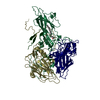
|
|---|---|
| 1 | x 60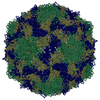
|
| 2 |
|
| 3 | x 5
|
| 4 | x 6
|
| 5 | 
|
| 対称性 | 点対称性: (シェーンフリース記号: I (正20面体型対称)) |
- 要素
要素
| #1: タンパク質 | 分子量: 31207.117 Da / 分子数: 1 / 由来タイプ: 天然 由来: (天然)  Coxsackievirus B1 (コクサッキーウイルス) Coxsackievirus B1 (コクサッキーウイルス)参照: UniProt: W8GTF7 |
|---|---|
| #2: タンパク質 | 分子量: 29122.744 Da / 分子数: 1 / 由来タイプ: 天然 由来: (天然)  Coxsackievirus B1 (コクサッキーウイルス) Coxsackievirus B1 (コクサッキーウイルス)参照: UniProt: A0A2S0RQC2 |
| #3: タンパク質 | 分子量: 26328.764 Da / 分子数: 1 / 由来タイプ: 天然 由来: (天然)  Coxsackievirus B1 (コクサッキーウイルス) Coxsackievirus B1 (コクサッキーウイルス)参照: UniProt: A0A0G4PYT0 |
| #4: タンパク質 | 分子量: 7484.246 Da / 分子数: 1 / 由来タイプ: 天然 由来: (天然)  Coxsackievirus B1 (コクサッキーウイルス) Coxsackievirus B1 (コクサッキーウイルス)参照: UniProt: A0A2S1FMR1 |
| #5: 化合物 | ChemComp-PLM / |
| 研究の焦点であるリガンドがあるか | Y |
-実験情報
-実験
| 実験 | 手法: 電子顕微鏡法 |
|---|---|
| EM実験 | 試料の集合状態: PARTICLE / 3次元再構成法: 単粒子再構成法 |
- 試料調製
試料調製
| 構成要素 | 名称: Coxsackievirus B1 / タイプ: VIRUS / Entity ID: #1-#4 / 由来: NATURAL |
|---|---|
| 由来(天然) | 生物種:  Coxsackievirus B1 (コクサッキーウイルス) Coxsackievirus B1 (コクサッキーウイルス) |
| ウイルスについての詳細 | 中空か: NO / エンベロープを持つか: NO / 単離: STRAIN / タイプ: VIRION |
| 緩衝液 | pH: 7.4 |
| 試料 | 包埋: NO / シャドウイング: NO / 染色: NO / 凍結: YES |
| 急速凍結 | 凍結剤: ETHANE |
- 電子顕微鏡撮影
電子顕微鏡撮影
| 実験機器 |  モデル: Tecnai F30 / 画像提供: FEI Company |
|---|---|
| 顕微鏡 | モデル: FEI TECNAI F30 |
| 電子銃 | 電子線源:  FIELD EMISSION GUN / 加速電圧: 300 kV / 照射モード: FLOOD BEAM FIELD EMISSION GUN / 加速電圧: 300 kV / 照射モード: FLOOD BEAM |
| 電子レンズ | モード: BRIGHT FIELD |
| 撮影 | 電子線照射量: 25 e/Å2 / 検出モード: INTEGRATING フィルム・検出器のモデル: FEI FALCON III (4k x 4k) |
- 解析
解析
| CTF補正 | タイプ: PHASE FLIPPING ONLY |
|---|---|
| 3次元再構成 | 解像度: 3.2 Å / 解像度の算出法: FSC 0.143 CUT-OFF / 粒子像の数: 35999 / 対称性のタイプ: POINT |
 ムービー
ムービー コントローラー
コントローラー









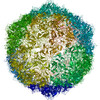




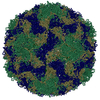
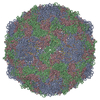
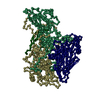
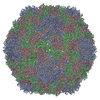
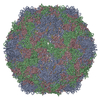
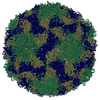
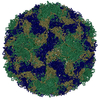
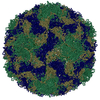


 PDBj
PDBj



